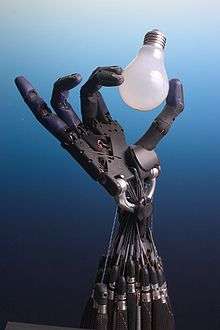Cartesian coordinate robot


A cartesian coordinate robot (also called linear robot) is an industrial robot whose three principal axis of control are linear (i.e. they move in a straight line rather than rotate) and are at right angles to each other.The three sliding joints correspond to moving the wrist up-down,in-out,back-forth. Among other advantages, this mechanical arrangement simplifies the Robot control arm solution. Cartesian coordinate robots with the horizontal member supported at both ends are sometimes called Gantry robots; mechanically, they resemble gantry cranes, although the latter are not generally robots. Gantry robots are often quite large.
A popular application for this type of robot is a computer numerical control machine (CNC machine) and 3D printing. The simplest application is used in milling and drawing machines where a pen or router translates across an x-y plane while a tool is raised and lowered onto a surface to create a precise design. Pick and place machines and plotters are also based on the principal of the cartesian coordinate robot.
See also
- Google 3D warehouse
- Sketchup
- Thingiverse
